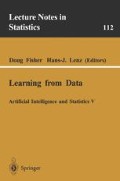Abstract
Decision making under uncertainty typically requires an iterative process of information acquisition. At each stage, the decision maker chooses the next best test (or tests) to perform, and re-evaluates the possible decisions. Value-of-information analyses provide a formal strategy for selecting the next test(s). However, the complete decision-theoretic approach is impractical and researchers have sought approximations.
In this paper, we present strategies for both myopic and limited non-myopic (working with known test groups) test selection in the context of belief networks. We focus primarily on utility-free test selection strategies. However, the methods have immediate application to the decision-theoretic framework.
Access this chapter
Tax calculation will be finalised at checkout
Purchases are for personal use only
Preview
Unable to display preview. Download preview PDF.
References
Almond, R.G. [ 1993 ]. “Lack of Information Based Control in Expert Systems.” In Hand, D.J (ed). Artificial Intelligence Frontiers in Statistics: AI and Statistics III, Chapman and Hall, pp 82–89.
Almond, R.G. [1995]. Graphical Belief Modelling. Chapman and Hall, in press.
Almond, R.G., M.Y. Jaisimha, E. Arbogast, and S.F. Elston[1994]. “Intelli-gent Image Browsing and Feature Extraction.” StatSci Research Report No. 25, 1700 Westlake Ave, N. Suite 500, Seattle, WA 98117.
Almond, R.G., and D. Madigan[1993].“Using GRAPHICAL-BELIEF to Predict Risk for Coronary Artery Disease.” StatSci Research Report No. 19, 1700 Westlake Ave, N. Suite 500,Seattle, WA 98117.
Barr, A. and Feigenbaum, E. [ 1982 ]. Handbook of Artificial Intelligence, volume 2. Kaufmann, Los Altos.
Ben-Basset, M. [ 1978 ]. “Myopic policies in sequential classification.” IEEE Transactions on Computing, (27, 170–174.
Breiman, L., J. Friedman, and C. Stone[1984].Classification and Regression Trees. Wadsworth International.
Buntine, W.[ 1994 ]. “Learning with Graphical Models.” Journal of Artificial Intelligence Research„ (2, 159–225.
Dawid, A. P. [ 1992 ]. “Applications of a general propagation algorithm for probabilistic expert systems.” Statistics and Computing, (2), 25–36.
Detrano, R., A. Janosi, W. Steinbrunn, M. Pfisterer, J-J. Schmid, S. Sandhu, K.H. Guppy, S. Lee, and V. Froelicher [ 1989 ]. “International Application of a New Probability Algorithm for the Diagnosis of Coronary Artery Disease.” American Journal of Cardiology, (64) 304–310.
Geyer, C.J. [ 1993 ]. “Practical Markov chain Monte Carlo.” Statistical Science, 8,. Glasziou, P. and J. Hilden[1989]. “Test Selection Measures.” Medical Decision Making (9), 133–141.
Good, I.J. [ 1985 ]. “Weight of Evidence: a brief survey.” In: Bayesian Statistics 2, Bernardo, J.M., DeGroot, M.H., Lindley, D.V., and Smith, A.F.M., eds, North Holland: New York, 249–269.
Good, I. J. and Card, W. [ 1971 ]. “The diagnostic process with special reference to errors.” Method of Inferential Medicine. (10), 176–188.
Heckerman, D., E. Horvitz, and B. Middleton[1993].“An Approximate Nonmyopic Computation for Value of Information.” IEEE Transaction of Pattern Analysis and Machine Intelligence (15), 292–298.
Heckerman, D., E. Horvitz, and B.N. Nathwani[1992].“Toward normative expert systems: Part I. The Pathfinder Project.” Methods of Information in Medicine (31), 90–105.
Jensen, F.V. and J. Liang[1994].“drHugin: A system for hypothesis driven data 98 David Madigan and Russell G. Almond
request.“ In: Bayesian Belief Networks and Probabilistic Reasoning,Gammerman, A., ed., UNICOM: London, to appear.
Kong, A.[ 1991 ]. “Efficient Methods for Computing Linkage Likelihoods of Recessive Diseases in Inbred Pedigrees.” Genetic Epidemiology, 8, 81–103.
Lin, S. [ 1992 ]. “On the performance of Markov chain Monte Carlo methods on pedigree data and a new algorithm.” Technical Report 231, Department of Statistics, University of Washington.
Madigan, D., Mosurski, K., and Almond, R.G. [ 1994 ]. “Explanation in Belief Networks.” Submitted for publication.
Madigan, D. and Almond, R.G.[ 1993 ]. “Test Selection Strategies for Belief Networks” StatSci Research Report 20.
McSherry, D.M.G.[ 1986 ]. “Intelligent dialogue based on statistical models of clinical decision making.” Statistics in Medicine, 5, 497–502.
Matheson, J.E.[ 1990 ]. “Using Influence Diagrams to Value Information and Control.” Influence Diagrams, Belief Nets and Decision Analysis, Oliver, Robert M. and Smith James Q. (ed.) John Wiley & Sons.
Miller, P. [ 1983 ]. “ATTENDING: Critiquing a physician’s management plan.” IEEE Transactions on Pattern Analysis and Machine Intelligence, (5, 449–461.
Murphy, P.M. and Aha, D.W.[ 1992 ]. UCI Repository of Machine Learning Databases. Online database maintained at the Department of Information and Computer Science, University of California, Irvine, CA.
Neal, R.M. [ 1993 ]. “Probabilistic inference using Markov chain Monte Carlo methods.” Technical Report CRG-TR-93–1, Department of Computer Science, University of Toronto.
Raftery, A.E. and Lewis, S.L. [ 1992 ]. “How many iterations in the Gibbs sampler?” In: Bayesian Statistics.4, Bernardo, J.M., Berger, J.O., Dawid, A.P. and Smith, A.F.M., eds, Oxford University Press: Oxford, 763–773.
Shenoy, P.P. and Shafer, G. [ 1990 ]. “Axioms for Probability and Belief-Function Propagation.” in Uncertainty in Artificial Intelligence, 4, 169–198.
Spiegelhalter, D.J. and Knill-Jones, R.P. [ 1984 ]. “Statistical and knowledge based approaches to clinical decision support systems, with an application in gastroenterology (with discussion).” Journal of the Royal Statistical Society (Series A) (147), 35–77.
Author information
Authors and Affiliations
Editor information
Editors and Affiliations
Rights and permissions
Copyright information
© 1996 Springer-Verlag New York, Inc.
About this chapter
Cite this chapter
Madigan, D., Almond, R.G. (1996). On Test Selection Strategies for Belief Networks. In: Fisher, D., Lenz, HJ. (eds) Learning from Data. Lecture Notes in Statistics, vol 112. Springer, New York, NY. https://doi.org/10.1007/978-1-4612-2404-4_9
Download citation
DOI: https://doi.org/10.1007/978-1-4612-2404-4_9
Publisher Name: Springer, New York, NY
Print ISBN: 978-0-387-94736-5
Online ISBN: 978-1-4612-2404-4
eBook Packages: Springer Book Archive

